Okta - Bring Your Own Telephony (BYOT) via Voice
Overview
This guide demonstrates how to implement voice-based One-Time Password (OTP) delivery for Okta authentication using 8x8's Voice API. This integration allows you to create a custom telephony provider that delivers OTPs via voice calls instead of SMS.
The integration works by creating a webhook service that receives OTP delivery requests from Okta's Inline Hook and uses 8x8's Voice API to deliver the OTP via a voice call to the user's phone number.
Integration Flow
Detailed Flow:
- User initiates login with multi-factor authentication enabled
- Okta triggers the Inline Hook with user details and OTP
- Your webhook service receives the request and extracts phone number and OTP
- Service calls 8x8 Voice API to initiate a voice call with the OTP message
- User receives voice call with spoken OTP and completes authentication
Prerequisites
Before you begin, ensure you have:
- Okta Account with admin access to configure Inline Hooks
- 8x8 Account with access to Voice API credentials
- JavaScript/Node.js knowledge for backend development
- Public HTTPS endpoint for receiving Okta webhooks (consider using ngrok for development)
Requirements
- Node.js
- npm package manager
Implementation
Step 1: Backend Code Setup
Create a new Node.js project and install dependencies:
mkdir okta-voice-otp
cd okta-voice-otp
npm init -y
npm install express dotenv
Step 2: Environment Configuration
Create a .env file with your configuration:
# Server Configuration
PORT=3000
OKTA_SECRET=your_okta_webhook_secret_here
# 8x8 Voice API Configuration
EIGHTYEIGHTX_SUBACCOUNT_ID=your_subaccount_id
EIGHTYEIGHTX_API_KEY=your_api_key
EIGHTYEIGHTX_SOURCE_NUMBER=+1234567890
# Voice Configuration
VOICE_PROFILE=en-US-Jenny
OTP_REPETITIONS=2
Step 3: Main Server Implementation
Create server.js:
const express = require('express');
const https = require('https');
const dotenv = require('dotenv');
dotenv.config();
const app = express();
const PORT = process.env.PORT || 3000;
// Middleware
app.use(express.json());
// Health check endpoint
app.get('/health', (req, res) => {
res.status(200).json({ status: 'OK', timestamp: new Date().toISOString() });
});
/**
* Sends an OTP to a user via an 8x8 voice call.
* @param {string} phoneNumber - The recipient's phone number in E.164 format
* @param {string} otpCode - The one-time password to be delivered
* @returns {Promise<Object>} Response from 8x8 API
*/
async function sendVoiceOTP(phoneNumber, otpCode) {
const subaccountId = process.env.EIGHTYEIGHTX_SUBACCOUNT_ID;
const apiKey = process.env.EIGHTYEIGHTX_API_KEY;
const sourceNumber = process.env.EIGHTYEIGHTX_SOURCE_NUMBER;
const voiceProfile = process.env.VOICE_PROFILE || 'en-US-Jenny';
const repetitions = parseInt(process.env.OTP_REPETITIONS) || 2;
const payload = JSON.stringify({
callflow: [
{
action: 'makeCall',
params: {
source: sourceNumber,
destination: phoneNumber
}
},
{
action: 'say',
params: {
text: `Your verification code is ${otpCode.split('').join(', ')}. I repeat, your verification code is ${otpCode.split('').join(', ')}.`,
voiceProfile: voiceProfile,
repetition: repetitions
}
},
{
action: 'hangup'
}
]
});
const options = {
hostname: 'voice.wavecell.com',
port: 443,
path: `/api/v1/subaccounts/${subaccountId}/callflows`,
method: 'POST',
headers: {
'Content-Type': 'application/json',
'Authorization': `Bearer ${apiKey}`,
'Content-Length': Buffer.byteLength(payload)
}
};
return new Promise((resolve, reject) => {
const req = https.request(options, (res) => {
let data = '';
res.on('data', (chunk) => {
data += chunk;
});
res.on('end', () => {
try {
const response = JSON.parse(data);
if (res.statusCode >= 200 && res.statusCode < 300) {
console.log('[8x8 Service] Voice call initiated successfully:', response);
resolve(response);
} else {
console.error('[8x8 Service] API error:', response);
reject(new Error(`8x8 API error: ${response.message || 'Unknown error'}`));
}
} catch (error) {
console.error('[8x8 Service] Failed to parse response:', error);
reject(error);
}
});
});
req.on('error', (error) => {
console.error('[8x8 Service] Request error:', error);
reject(error);
});
req.write(payload);
req.end();
});
}
/**
* Validates the incoming Okta webhook request
* @param {Object} req - Express request object
* @returns {boolean} True if request is valid
*/
function validateOktaRequest(req) {
// For production, implement proper Okta webhook signature validation if needed
const oktaSecret = process.env.OKTA_SECRET;
const authHeader = req.headers.authorization;
// If auth header is provided, validate it
if (authHeader && oktaSecret) {
return authHeader === `Bearer ${oktaSecret}`;
}
// Allow requests without auth headers for simplicity
// In production, consider implementing webhook signature validation
return true;
}
// Okta Voice OTP webhook endpoint
app.post('/okta-voice-otp', async (req, res) => {
try {
console.log('[Server] Received Okta webhook request');
// Validate request
if (!validateOktaRequest(req)) {
console.warn('[Server] Unauthorized request received');
return res.status(401).json({ error: 'Unauthorized' });
}
// Extract data from Okta payload
const { data } = req.body;
if (!data || !data.userProfile || !data.messageProfile) {
console.error('[Server] Invalid Okta payload structure');
return res.status(400).json({ error: 'Invalid payload structure' });
}
const phoneNumber = data.messageProfile.phoneNumber || data.userProfile.mobilePhone;
const otpCode = data.messageProfile.otpCode;
if (!phoneNumber || !otpCode) {
console.error('[Server] Missing phone number or OTP code');
return res.status(400).json({ error: 'Missing required fields' });
}
console.log(`[Server] Processing OTP delivery for ${phoneNumber.replace(/\d(?=\d{4})/g, '*')}`);
// Respond to Okta immediately
res.status(200).json({
commands: [{
type: 'com.okta.telephony.action',
value: [{
status: 'SUCCESSFUL',
provider: '8x8-voice'
}]
}]
});
// Handle voice call asynchronously
try {
await sendVoiceOTP(phoneNumber, otpCode);
console.log('[Server] Voice OTP delivery initiated successfully');
} catch (error) {
console.error('[Server] Failed to send voice OTP:', error.message);
// Note: We already responded to Okta, so this is logged for monitoring
}
} catch (error) {
console.error('[Server] Webhook processing error:', error);
res.status(500).json({ error: 'Internal server error' });
}
});
// Global error handler
app.use((error, req, res, next) => {
console.error('[Server] Unhandled error:', error);
res.status(500).json({ error: 'Internal server error' });
});
// Start server
app.listen(PORT, () => {
console.log(`[Server] Voice OTP service running on port ${PORT}`);
console.log(`[Server] Webhook endpoint: http://localhost:${PORT}/okta-voice-otp`);
});
module.exports = app;
Step 4: Package Configuration
Update your package.json:
{
"name": "okta-voice-otp",
"version": "1.0.0",
"description": "Okta BYOT with 8x8 Voice API for OTP delivery",
"main": "server.js",
"scripts": {
"start": "node server.js",
"dev": "node server.js"
},
"keywords": ["okta", "8x8", "voice", "otp", "byot"],
"author": "Your Name",
"license": "MIT",
"dependencies": {
"express": "^4.18.0",
"dotenv": "^16.0.0"
}
}
Configuration
Step 5: Okta Inline Hook Setup
-
Access Okta Admin Console
- Log into your Okta organization as an administrator
- Navigate to Workflow > Inline Hooks
-
Create New Inline Hook
- Click Add Inline Hook
- Select Telephony as the hook type
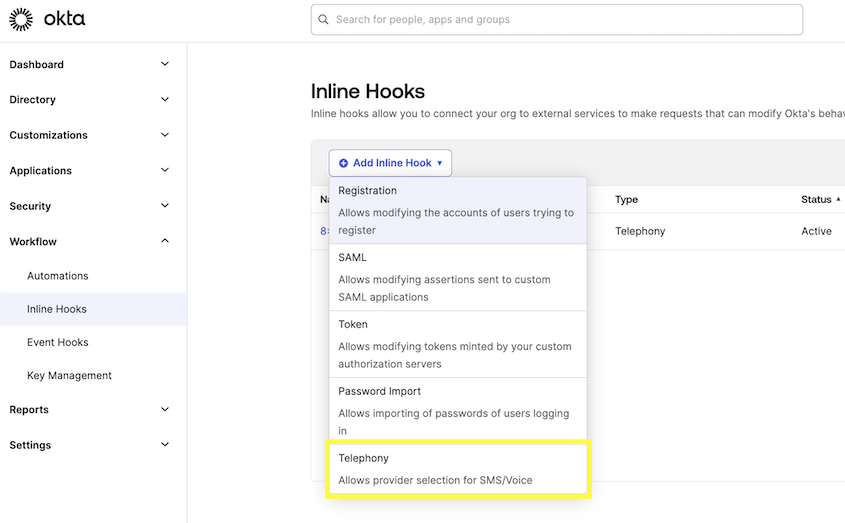
-
In the Create Inline Hook page, fill in the following values.
Field Description Example Value Name Can be any value. We use "8x8 - Voice Authentication" 8x8 - Voice Authentication URL Should be set to the URL of your backend server that you send the code. https://example.com/endpoint Authentication Field Will be sent as part of the request header. Authentication Field is for your backend to authenticate the webhook from Okta. It can be any value
Refer to Okta's page on authentication and Inline Hooks for reference.Authentication Authentication Secret (Used with Authentication Field) Will be sent as part of the request header. This should be the value your backend uses to authenticate secretvalue After entering the values, click Save.
-
Configure Hook Settings
- Set the hook to trigger on authentication events
- Enable the hook for your organization
Step 6: Authentication Policy Configuration
-
Create Authentication Policy
- Navigate to Security > Authentication > Authentication Policies
- Create a new policy or edit existing one
-
Configure MFA Rules
- Add a rule that requires phone verification
- Set the telephony provider to use your custom hook
- Configure when voice calls should be used (fallback, primary, etc.)
-
Assign Policy
- Assign the policy to relevant applications and user groups
Testing the Integration
Step 7: Test the Implementation
-
Start Your Service
npm start -
Expose Your Local Service (for development)
# Using ngrok
ngrok http 3000 -
Update Okta Hook URL with your ngrok URL
-
Test Authentication Flow
- Attempt to sign in to an application with MFA enabled
- Verify that voice call is initiated
- Complete authentication with received OTP
Request/Response Examples
Okta Webhook Request Example
{
"eventId": "rZxqX4QGT1KIwr8KSh3C6A",
"eventTime": "2025-09-29T09:05:04.000Z",
"eventType": "com.okta.telephony.provider",
"eventTypeVersion": "1.0",
"contentType": "application/json",
"cloudEventVersion": "0.1",
"source": "https://integrator-xxxxxx.okta.com/api/v1/inlineHooks/calhawlks9zOkRrau0h7",
"requestType": "com.okta.user.telephony.mfa-verification",
"data": {
"context": {
"request": {
"id": "8d9c47117943da0585412539965xxxx",
"method": "POST",
"url": {
"value": "/api/internal/v1/inlineHooks/com.okta.telephony.provider/generatePreview"
},
"ipAddress": "42.61.17.54"
}
},
"userProfile": {
"firstName": "Harris",
"lastName": "Doe",
"login": "harris@example.com",
"userId": "00uvw9bdliXTkH8qR697"
},
"messageProfile": {
"msgTemplate": "Your code is 11111",
"phoneNumber": "9876543210",
"otpExpires": "2025-09-29T09:09:59.759Z",
"deliveryChannel": "Voice",
"otpCode": "11111",
"locale": "en"
}
}
}
Your Service Response Example
{
"error": null,
"commands": [
{
"type": "com.okta.telephony.action",
"value": [
{
"status": "SUCCESSFUL",
"provider": "8x8-voice",
"transactionId": null,
"transactionMetadata": null
}
]
}
],
"debugContext": {}
}
Using the Inline Hook
Now that the Inline Hook has been added, in order to require it for signing into your Okta organization.
Add Authenticator
Ensure that in the Security - Authenticators page that Phone is added as an Authenticator option.
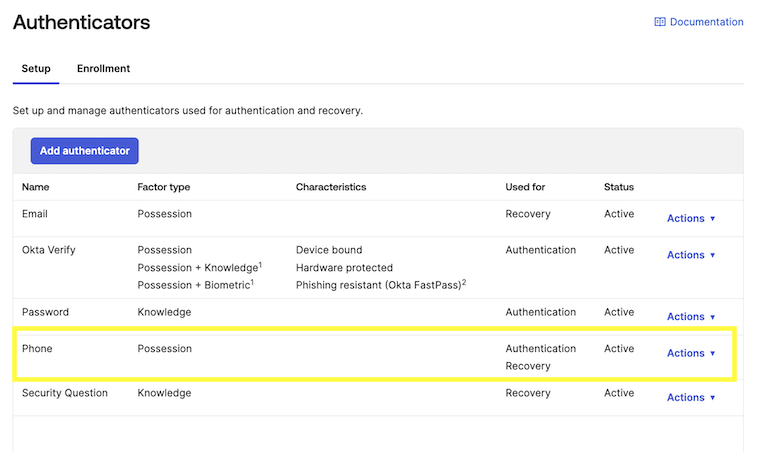
If it is not already on the list then click Add Authenticator to add it.
Create new Authentication Policy Rule
Click Add Rule on the Security - Authentication Policies page.

In the Edit Rule page, the only change we will make is for AND Authentication methods where we should include the Phone - Voice method along with any other methods we wish to offer the user authenticating into Okta.
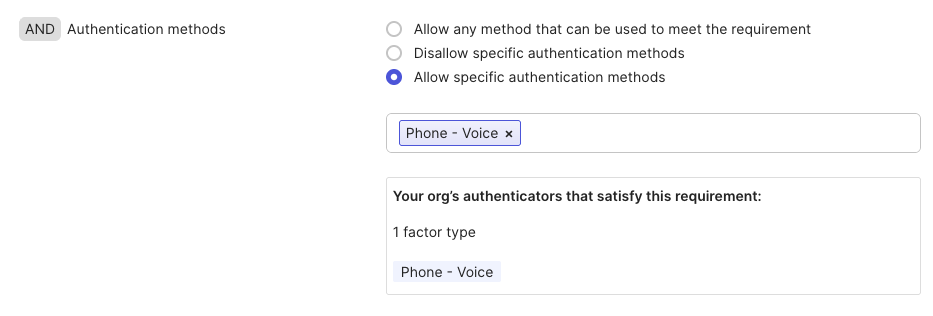
Add to Application
After creating the Policy, add it to one of your Applications.
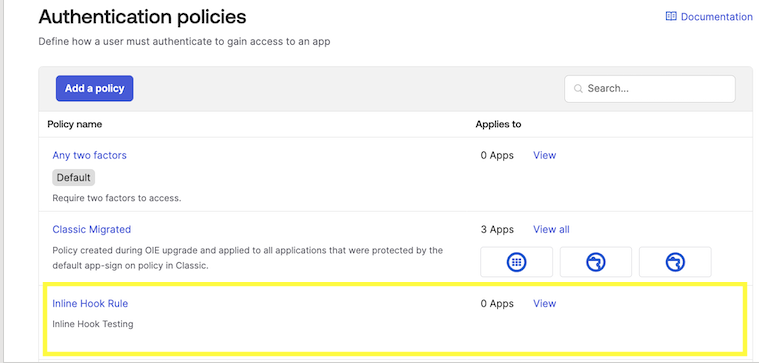
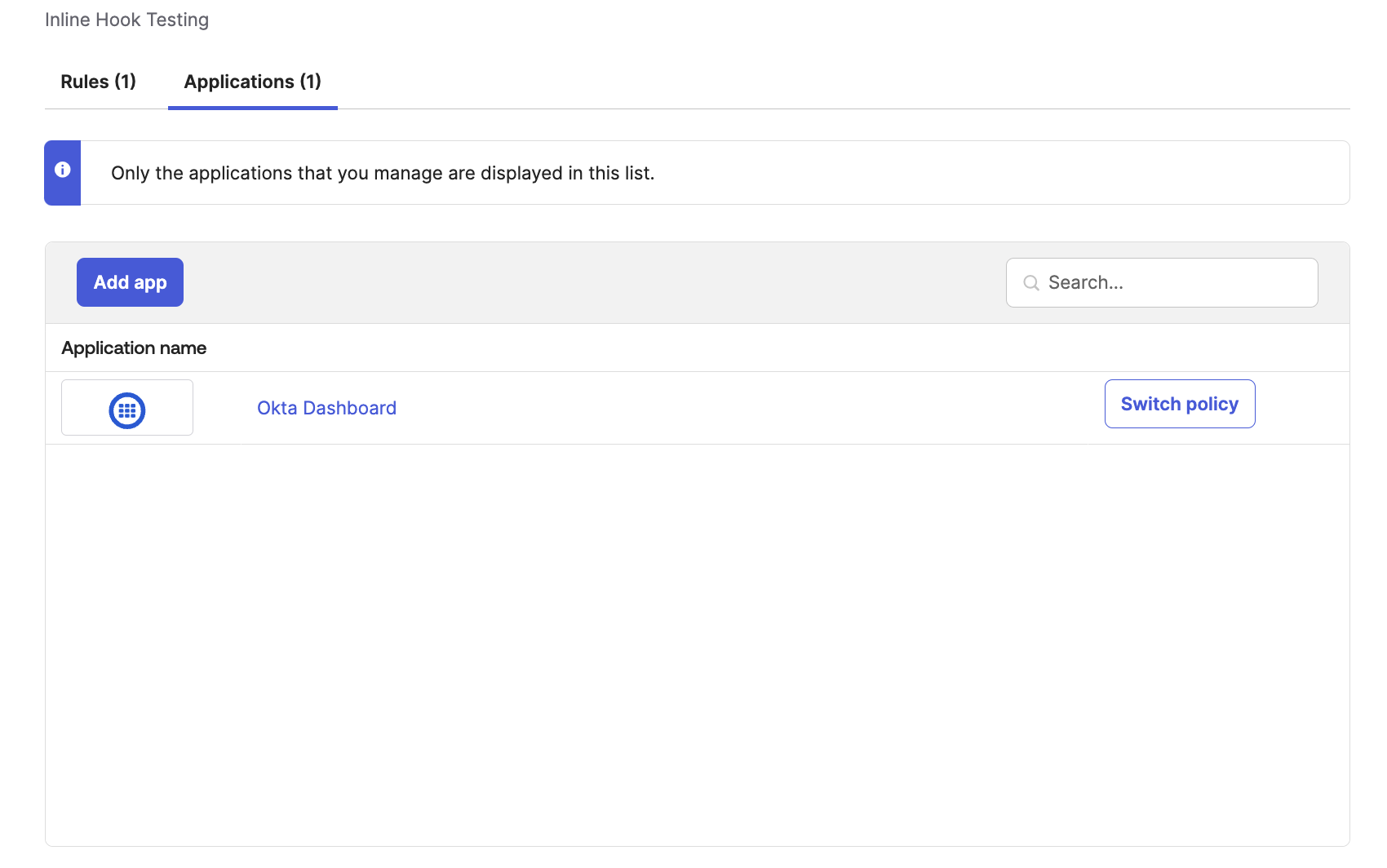
Signing In
When attempting to login to the application that you have configured above, you should receive the following screen prompting you to register for Phone Verification.
The code should be sent to your phone via a phone call, follow the prompts to finish logging into application.
Security Considerations
- Webhook Validation: Implement proper signature validation for production use
- Environment Variables: Never hardcode credentials in your source code
- HTTPS: Always use HTTPS for webhook endpoints in production
- Rate Limiting: Implement rate limiting to prevent abuse
- Logging: Log events for monitoring but avoid logging sensitive data
Troubleshooting
Common Issues
-
Voice call not initiated
- Verify 8x8 API credentials and subaccount ID
- Check phone number format (E.164)
- Review API response for error messages
-
Okta webhook not received
- Confirm webhook URL is accessible from internet
- Verify SSL certificate is valid
- Check Okta hook configuration and authentication
-
Authentication failures
- Validate webhook secret configuration
- Review request headers and authentication method
Monitoring and Logs
Monitor your service logs for:
- Incoming Okta webhook requests
- 8x8 API responses
- Error conditions and failed calls
- Performance metrics
Conclusion
You've successfully implemented voice-based OTP delivery for Okta using 8x8's Voice API. This integration provides an alternative to SMS for users who prefer or require voice-based authentication methods.